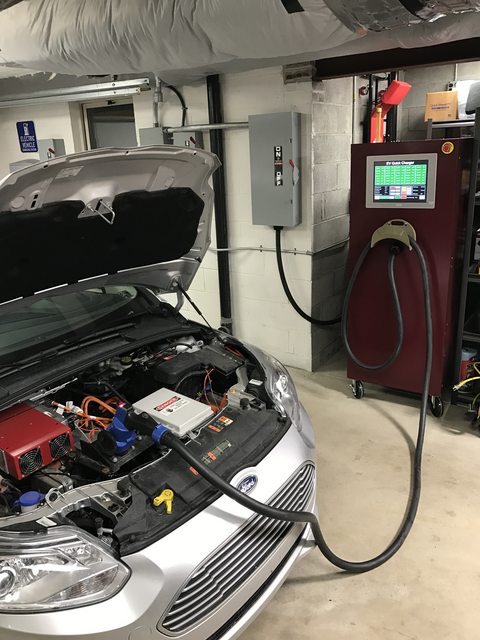sefs
Well-known member
Hey everyone,
I thought I'd post an update as to what I'm up to these days. I decided all the CAN knowledge I gained from the Chademo project would be well served taking four FFE chargers from salvage and putting them together for a Home Quick Charger
I'm in the validation phase of the control systems and cooling, but as of right now, I can quick charge my FFE at home from 0% to 100% in 45 minutes
Right now it's all arranged for prototyping, but an enclosure is in the works to be complete with industrial Pro-face touch screen, illuminated start/stop buttons, and mushroom E-stop switch. I'm definitely implementing Chademo with my charger, and I might do CCS in the future as well.
Key stats:
- Peak AC current: 115 A on a 150 A circuit breaker
- Peak DC current: 80 A
- Efficiency ~93%
- Peak AC power: 26 kW
- Peak DC Power 24 kW

This is a shot of the inside of one of the chargers. I can't tell you how long I looked for this, as well as who made it. It turns out TDK Corporation of Japan made these for Ford.

Here is a shot of the FFE Quick Charging. I'm going to build an enclosure for the chargers and everything, but here is the touch screen that it will center around. I'll have all the buttons and E-stops as well.

Here is another shot of the prototype hardware. You can see the subpanel by the charger stack. This will be with the Quick Charger enclosure. That's 2 AWG industrial extension cable feeding the subpanel. It's fed by a 200A transfer switch protected by a 150A breaker.

Finally, a close up of the charger stack. Coolant tubing and all. I have purchased larger radiators, as this one I have now is not up to the task.
I thought I'd post an update as to what I'm up to these days. I decided all the CAN knowledge I gained from the Chademo project would be well served taking four FFE chargers from salvage and putting them together for a Home Quick Charger
I'm in the validation phase of the control systems and cooling, but as of right now, I can quick charge my FFE at home from 0% to 100% in 45 minutes
Right now it's all arranged for prototyping, but an enclosure is in the works to be complete with industrial Pro-face touch screen, illuminated start/stop buttons, and mushroom E-stop switch. I'm definitely implementing Chademo with my charger, and I might do CCS in the future as well.
Key stats:
- Peak AC current: 115 A on a 150 A circuit breaker
- Peak DC current: 80 A
- Efficiency ~93%
- Peak AC power: 26 kW
- Peak DC Power 24 kW

This is a shot of the inside of one of the chargers. I can't tell you how long I looked for this, as well as who made it. It turns out TDK Corporation of Japan made these for Ford.

Here is a shot of the FFE Quick Charging. I'm going to build an enclosure for the chargers and everything, but here is the touch screen that it will center around. I'll have all the buttons and E-stops as well.

Here is another shot of the prototype hardware. You can see the subpanel by the charger stack. This will be with the Quick Charger enclosure. That's 2 AWG industrial extension cable feeding the subpanel. It's fed by a 200A transfer switch protected by a 150A breaker.

Finally, a close up of the charger stack. Coolant tubing and all. I have purchased larger radiators, as this one I have now is not up to the task.











![4 Ports Fast Car Charger,[Upgrade Voltmeter Display] PD+QC3.0+USB C Car Charger for 12-24V Cigarette Lighter Plug,Car Phone Charger Compatible with iPhone/Android/Samsung/iPad (QC3.0+Type-C+PD+2.4A)](https://m.media-amazon.com/images/I/41Zu+AlABTL._SL500_.jpg)



























